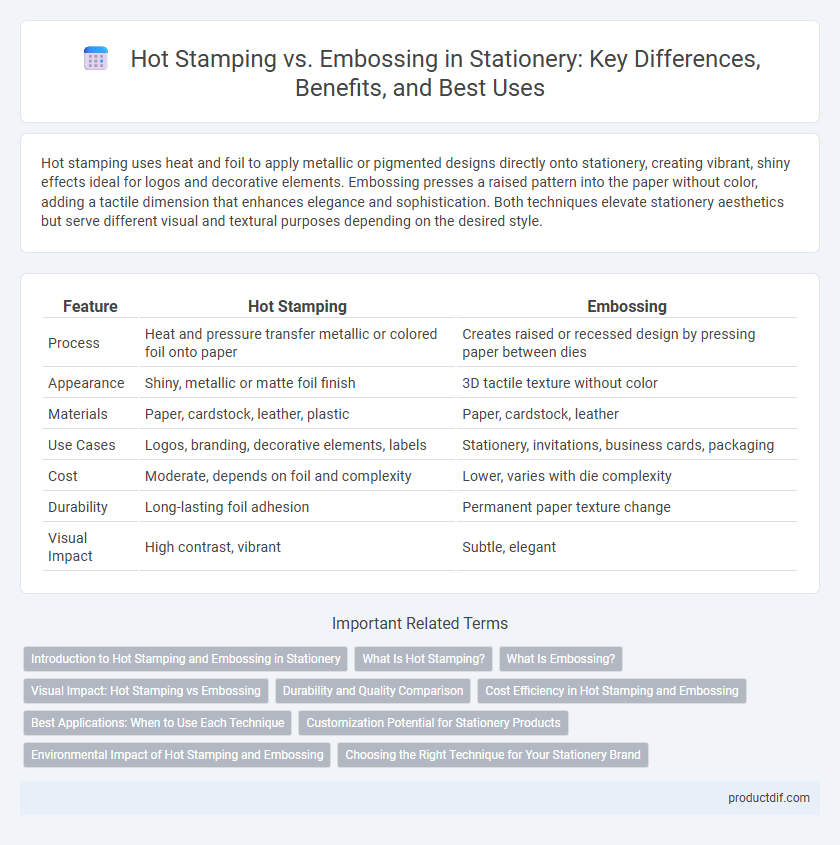Hot stamping uses heat and foil to apply metallic or pigmented designs directly onto stationery, creating vibrant, shiny effects ideal for logos and decorative elements. Embossing presses a raised pattern into the paper without color, adding a tactile dimension that enhances elegance and sophistication. Both techniques elevate stationery aesthetics but serve different visual and textural purposes depending on the desired style.
Table of Comparison
| Feature | Hot Stamping | Embossing |
|---|---|---|
| Process | Heat and pressure transfer metallic or colored foil onto paper | Creates raised or recessed design by pressing paper between dies |
| Appearance | Shiny, metallic or matte foil finish | 3D tactile texture without color |
| Materials | Paper, cardstock, leather, plastic | Paper, cardstock, leather |
| Use Cases | Logos, branding, decorative elements, labels | Stationery, invitations, business cards, packaging |
| Cost | Moderate, depends on foil and complexity | Lower, varies with die complexity |
| Durability | Long-lasting foil adhesion | Permanent paper texture change |
| Visual Impact | High contrast, vibrant | Subtle, elegant |
Introduction to Hot Stamping and Embossing in Stationery
Hot stamping in stationery involves applying metallic or colored foil onto paper through heat and pressure, creating vibrant, reflective designs that enhance visual appeal. Embossing raises specific areas of the paper by pressing it between two molds, producing a tactile, three-dimensional effect that adds texture and depth to stationery products. Both techniques are widely used for branding, invitations, and luxury packaging to create distinctive and premium finishes.
What Is Hot Stamping?
Hot stamping is a versatile printing technique that uses heat, pressure, and metallic or pigmented foil to create a distinctive, shiny design on stationery materials like cards, covers, and labels. It produces vibrant, durable impressions with a high level of detail, making it ideal for logos, text, and decorative elements. Unlike embossing, hot stamping applies color and texture simultaneously, enhancing both visual appeal and tactile experience.
What Is Embossing?
Embossing is a stationery technique that creates a raised, three-dimensional design on paper or cardstock by pressing it between two engraved metal dies. This process adds texture and depth, enhancing the visual appeal and tactile experience of invitations, business cards, and packaging. Unlike hot stamping, embossing does not involve color transfer but relies solely on the physical impression of the design.
Visual Impact: Hot Stamping vs Embossing
Hot stamping creates vibrant, metallic effects by applying foil with heat, resulting in sharp and reflective visuals that enhance stationery elegance. Embossing raises the surface of the paper, adding tactile depth and subtle shadows that appeal through texture rather than color. The choice between hot stamping and embossing depends on whether a glossy, high-contrast look or a sophisticated, textured finish is desired for visual impact.
Durability and Quality Comparison
Hot stamping offers superior durability due to its use of heat and foil, producing vibrant, long-lasting finishes resistant to wear and fading. Embossing provides a textured, tactile quality that enhances the visual appeal but may wear down more quickly under frequent handling. Both techniques deliver high-quality results, with hot stamping excelling in color retention and embossing excelling in dimensional impact.
Cost Efficiency in Hot Stamping and Embossing
Hot stamping generally offers better cost efficiency for large print runs due to lower setup and production costs, especially when applying metallic foils or vibrant colors. Embossing involves higher initial tooling expenses and longer processing times, making it more suitable for premium or limited-edition stationery where tactile quality justifies the investment. Choosing between hot stamping and embossing depends on balancing budget constraints with desired aesthetic and textural effects in stationery design.
Best Applications: When to Use Each Technique
Hot stamping produces vibrant, metallic finishes ideal for luxury packaging, invitations, and brand logos needing high visual impact. Embossing creates raised impressions that add tactile elegance and depth, perfect for business cards, letterheads, and stationery requiring subtle sophistication. Choose hot stamping for eye-catching color effects and embossing for texture-driven design elements in stationery products.
Customization Potential for Stationery Products
Hot stamping offers higher customization potential for stationery products by allowing precise, multi-color metallic and foil designs that enhance visual appeal and brand identity. Embossing provides a subtle, tactile dimension by creating raised impressions, ideal for elegant, minimalist customization without color. Combining both techniques can elevate stationery customization, merging vibrant visuals with sophisticated textures.
Environmental Impact of Hot Stamping and Embossing
Hot stamping typically uses metallic foils and heat, leading to increased energy consumption and non-biodegradable waste, impacting environmental sustainability. Embossing relies on physical pressure without chemical additives or foils, resulting in lower energy use and minimal waste generation. Choosing embossing over hot stamping reduces carbon footprint and favors eco-friendly stationery production.
Choosing the Right Technique for Your Stationery Brand
Hot stamping offers vibrant, metallic finishes ideal for luxury stationery brands seeking eye-catching logos, while embossing creates elegant, tactile impressions that emphasize subtle sophistication. Selecting the right technique depends on your brand's identity, target audience, and desired visual impact, with hot stamping enhancing color contrast and embossing providing a refined, textured experience. Consider cost-effectiveness and production volume as well, since hot stamping may incur higher expenses for intricate designs, whereas embossing suits minimalist aesthetics with lower set-up costs.
Hot stamping vs Embossing Infographic

 productdif.com
productdif.com